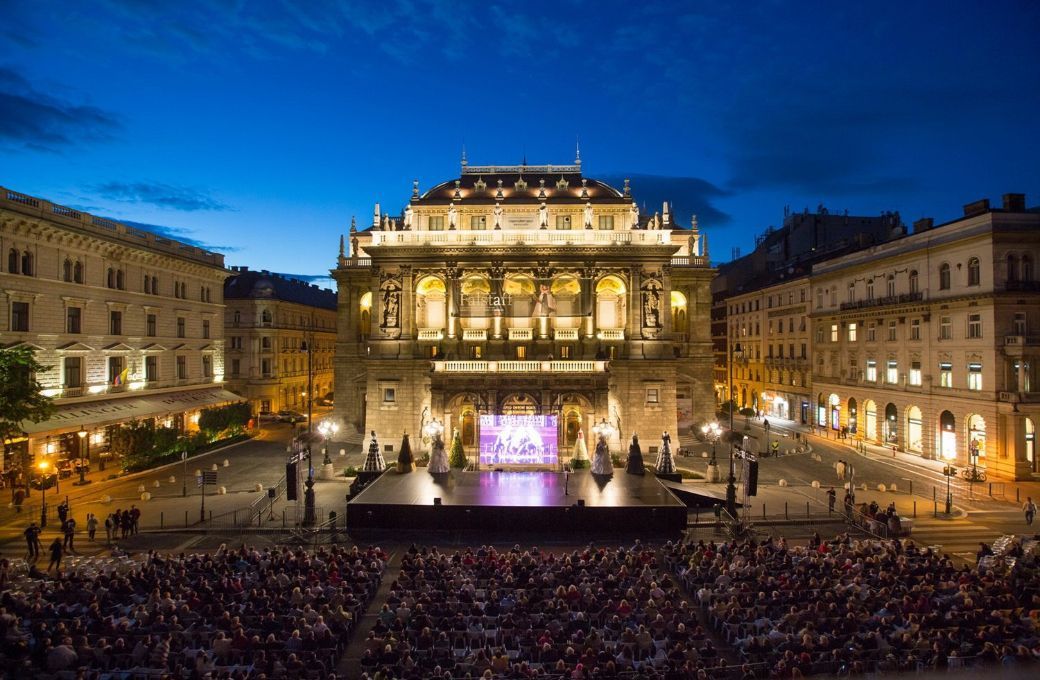The Hungarian State Opera season is one of the largest anywhere in Europe, and the 2023–24 offering is bigger than any before, starting this August and stretching into mid-August 2024 – making it a full 12-month season for the first time in a century. The sheer scale is overwhelming: 270 opera performances of 41 different operas, 16 of which are new productions or premieres. 130 performances of 19 ballets; and 50 concert performances.

With many guest and touring artists, spread across the three venues, this preview can only brush the surface of a season of this scale, and provide a few points of orientation. This year, the Hungarians are taking a distinctly Slavic route in their programming, notably in new productions of Boris Godunov and Rusalka. This direction was set right from the off with the 22nd August guest production of Karol Szymanowski’s Król Roger, a rarely heard gem, sung in Polish and performed by Slovakian National Theatre Košice Orchestra.
Yet there is plenty of non-Slavic fare at Budapest this season too. In September and October, Italian opera dominates, with Rossini’s rescue opera L’italiana in Algeri, followed by Verdi’s Nabucco from 7th October. A one-off performance of a new production of Donizetti’s Il campanello can also be seen at the smaller Eiffel Art Studios Bánffy Stage on 30th September.
Verdi fans will be treated to a veritable glut in summer 2024, where from June through August, the Hungarian State Opera will stage Aida, Rigoletto, La traviata and Un ballo in maschera, displaying the strength of the company’s established repertoire (and sheer stamina).
Likewise Wagner, always popular, is a major component of the season. Visitors to Budapest can see an entire Ring cycle, in stagings directed by Géza M Tóth, and also Parsifal, in András Almási-Toth’s well-received production revived from 2022. Another major revival this season is Calixto Bieito’s staging of Prokofiev’s behemoth War and Peace, five stars in our review from January this year.
However it is the new productions for 2024 that really pique the attention. Boris Godunov, from late April through to May, looks unmissable. András Almási-Toth directs, with Gábor Bretz in the title role. Shortly before this, Bretz will also be singing Don Giovanni, in another new production, on stage in March and directed by Claus Guth. Before this, the new production of Dvořák’s Rusalka, directed by János Szikora, will be on the boards from January to February.
New productions are not limited to opera either. In February the Hungarian National Ballet will stage all three of Bartók’s ballets – The Wooden Prince, The Miraculous Mandarin, and the Dance Suite – the latter two in new productions. The salacious Mandarin is a favourite of Bartokians everywhere but fairly infrequently staged even today.
As well as the Bartók triple bill, ballet audiences can look forward to revivals of Mikhail Messerer’s Don Quixote at the end of September, Lázló Seregi’s 1968 version of Spartacus in October, John Cranko’s universally acclaimed Onegin in January and Sir Kenneth MacMillan’s epic Mayerling in March and April 2024. Wayne Eagling and Tamás Solymosi’s ever popular The Nutcracker runs from November to January.
There are two fascinating quadruple bills in 2024 starting with Classical Bravura on April 20th which includes the Paquita Suite, two Jiří Kylián favourites, Petite Mort and Sechs Tänze, and closes with Harald Lander’s challenging but spectacular showcase Études. Starting on 3rd May, the second programme titled Frenetic Dance comprises Johan Inger’s Walking Mad, William Forsythe’s The Vertiginous Thrill of Exactitude, Hans van Manen’s Five Tangos and Lightfoot/León’s Sad Case.
Boris Eifmann’s The Pygmalion Effect is revived in May, followed by the 8th annual Iván Nagy International Ballet Gala, and the season’s closer of Anna-Marie Holmes’ sumptuous Le Corsaire, opening in June. Dace Radina will also present a series of ballets especially created for younger audiences, beginning with Little Swan Lake in October, a revival of her Little Sleeping Beauty in February, and Little Corsaire in May. These are likely to appeal to families with small children hoping to catch the ballet bug.
Returning to opera, there are several world premieres this season. Famed modernist Peter Eötvös’s new opera Valuska, based on László Krasznahorkai’s tragicomic stream-of-consciousness novel The Melancholy of Resistance, will be premiered in December. This is Eötvös’s 13th opera, and his first setting the Hungarian language. Also performed for the first time in December is György Selmeczi’s Artaban, based on Henry Van Dyke’s story of a supposed fourth wise man to visit the Nativity in Bethlehem. Less well-known outside of Hungary than Eötvös, Selmeczi is also a prolific composer of opera and oratorios and music theatre, as well as film scores.
Then there is the cavalcade of concert performances and recitals from soloists throughout the season: Piotr Beczała in November, Olga Peretyatko in January, Klára Kolonits and Ferruccio Furlanetto in February, Lisette Oropesa in May, to name a few.
In sum, there is simply too much going on in Budapest this season to fit into a preview of this length. Safe to say that the Hungarian State Opera are utterly resolute in confirming Budapest as a major world destination for opera and ballet.
See our complete listings for the Hungarian State Opera season 2023–24.
This preview was sponsored by Hungarian State Opera.


